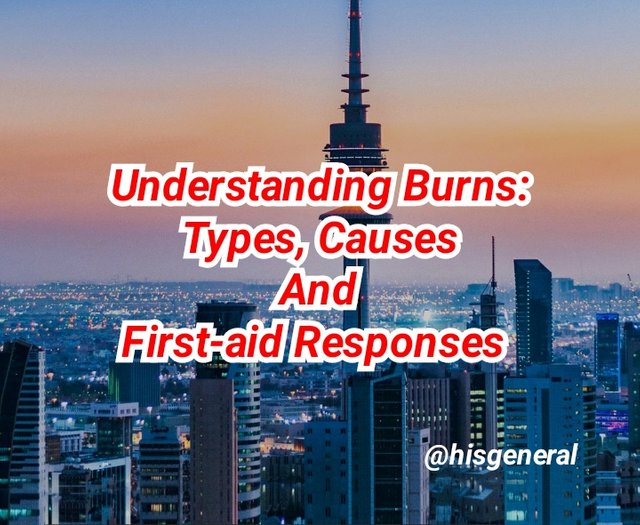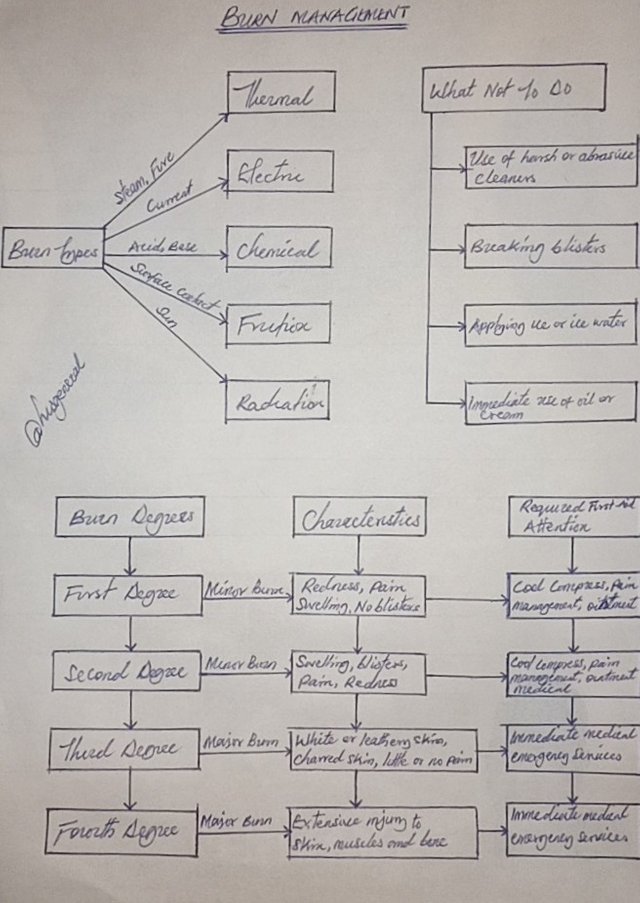Hi guys, it's good to have you on my blog so I say welcome. Let's discuss the issue on board...
 |
|---|
In such a situation, the immediate steps I would take are as follows:
- Terminate the burning process: I will be moving the child away from the burn source(the hot tea) to keep from further injury.
- Cool the burn: This will involve pouring or running cool tap water for 10-15 minutes over the burned area or placing a cool, wet compress. Using ice or ice water can cause further damage, so it is an unthinkable option.
- Removing clothing and jewelry: I will have to gently take away any clothing or jewelry (if any) around the burned area because it can stick to the burn and result in further damage.
- Assessing the burn: I will then examine how severe the burn is based on its size, depth, as well as location.
- Applying ice or ice water: I will avoid applying ice or ice water as it can result in further damage as well as may lead to hypothermia.
- Breaking blisters: I will also avoid breaking blisters as it can lead to infection.
- Applying butter, oil, or grease: This is also another action I will avoid because it can trap heat and make the burn worse.
- Use of harsh or abrasive cleansers: I will avoid the use of harsh or abrasive cleaners because they can further irritate the skin.
When evaluating the burn, I will consider the following factors to ascertain its severity:
- The Size: This implies how large the area of the body is covered by the burn. Burns are severe when they cover a large area of the body.
- The Depth: This will be to consider how deep the burn got into the skin. Burns are more severe when they affect the epidermis as well as the dermis layers of the skin.
- The Location: I will also consider the location of the burn. Burns are more severe when they affect sensitive parts of the body like the feet, face, genital area, or hands.
The reasons for these considerations are to determine the degree of the burn as well as the corresponding medical approach. Different degrees of burn require different medical attention.
For instance, while a first-degree burn; which is characterized by pain, redness, and swelling, but no blisters; will require cool compresses, pain management, and topical antibiotic ointment, a second-degree burn characterized by swelling, blisters, pain, and redness may require medical attention in addition to topical antibiotic ointment, cool compress, and pain management.
A third-degree burn characterized by white or leathery skin, little or no pain, and charred skin will require immediate medical emergency services, just as a fourth-degree burn characterized by extensive injury to the skin, muscle, and bone requires immediate emergency medical services.
- Making sure the scene is safe: Safety first. This is the first thing I would do, to ensure that the source of power is turned off or the victim is moved away from the source of electricity.
- Call for medical assistance: Since electrical burns can be extreme or brutal, I will call for immediate medical attention.
- Examine the victim's airway, breathing, and circulation (ABCs): Electrical burns can result in cardiac arrest, so it will be necessary to assess the victim's ABCs.
- If necessary provide cardiopulmonary resuscitation (CPR): After checking the victim's ABCs and the victim is either not breathing, unresponsive, or has no pulse, I will commence CPR.
- Removing clothing and jewelry: Jewelry is conductors; therefore, I will gently remove jewelry and clothing that may come in contact with the burn and worsen the damage.
- Clean the wound: I will gently clean the wound using cool or lukewarm water as well as mild soap and avoid the use of harsh or abrasive cleansers.
- Cover the wound: I will then protect the wound using a sterile and non-stick dressing or a clean and dry cloth.
- Touching the victim without turning off the power source: I will avoid this step because I can become an electricity conductor as well as receive a shock.
- Applying water to the victim while still in contact with the electrical source: This will be a dead end and must be avoided at all costs as water can equally conduct electricity and will worsen the damage.
- Using a metal or any conductive object to have the victim removed from the electrical source: This is a wrong and dangerous step that I will equally avoid, instead, in the absence of a rescue hook, I'd rather use a non-conductive object like a wooden broom handle.
- Applying ice or ice water: This I will also avoid as the application of ice or ice water can result in further injury to the skin as well as the underlying tissues.
Electrical burn attention differs from treatment for thermal burns in the following aspects:
- The path of injury: As the electric current travels through the entire body, its burns can result in internal injuries, whereas thermal burns usually only affect the skin as well as underlying tissues.
- Entrance and exit points: There are often distinct entrance and exit points in electrical burns, whereas such isn't obtainable in thermal burns.
- The depth of injury: As the electrical current can harm internal organs or tissues, electrical burns can result in deeper injuries than thermal burns.
- Cardiac complications: Electrical burns result in cardiac complications like cardiac arrest or arrhythmias, whilst on the contrary thermal burns do not ordinarily result in cardiac complications.
- Their treatment approach: A more cautious approach is required for electrical burns as the victim may have cardiac complications or internal damages. On the other hand, thermal burns can be more aggressively treated, with a concentration on cooling the burn as well as managing pain.
A. Type of Burn
The type of burn described in this scenario is a 'chemical burn', particularly an 'acid burn'. Chemical burns take place when there is a contact of the skin with a corrosive substance like a strong acid or base.
B. What Went Wrong During the Initial First Aid
In the course of the first first-aid, the colleague tried washing off the acid with water. Nevertheless, the approach can, as a matter of fact, worsen the burn. Here's the reason:
- Water can actuate the acid: Most acids, such as sulfuric acid, can when mixed with water, become extra corrosive. This can result in the spread and worsening of burn.
- Water can spread the acid: The acid can be spread to other areas of the skin by the splash of water, thereby increasing the burn size.
C. Correct First Aid Steps
- Flushing with copious amounts of water: Flushing the affected area with huge amounts of water assists in diluting and removing the acid, although it may appear counterintuitive. Notwithstanding, it's necessary to make use of a gentle flow of water to prevent the spreading of the acid.
- Removing contaminated clothing: This is the right step in the right direction, as removing any clothing or jewelry that may come into contact with the acid can assist in preventing additional skin contact and mitigate the risk of spreading the acid.
- If possible, neutralize the acid: Supposing the acid is a weak acid, like acetic acid (vinegar), neutralizing it with a weak base such as baking soda can be tried. Meanwhile, this should only be done based on the certainty of the type of acid as well as the suitable neutralizing agent.
- Application of a topical ointment: To assist prevent infection, a topical antibiotic ointment can be applied to the affected area.
- Cover the wound: Protect the wound using a sterile and non-stick dressing or a clean and dry cloth to keep it from additional irritation.
- Seek medical attention: Chemical burns can be severe and call for immediate medical attention. Immediate medical help should be sought, even if the burn appears minor.
Why Each Step is Important
Each step is essential for the provision of efficient first aid for a chemical or acid burn. Flushing the affected area using water assists in diluting and removing the acid, while the removal of contaminated clothing hinders further skin contact. Neutralizing the acid where possible can assist in reducing the seriousness of the burn.
Application of a topical ointment and protecting the wound assists in preventing infection and promoting healing. Ultimately, seeking medical attention makes sure that the burn is given adequate treatment and lowers the risk of complications.
Prioritization Decision
In this situation, I would prioritize Person B, who is in severe pain and has second-degree burns on both legs.
The following medical and ethical considerations are the basis for my decisions:
Medical Considerations
- Risk of shock: Person B, who has a second-degree burn on both legs, is prone to a higher risk of developing shock resulting from the massive surface area affected. Shock can result in the failure of an organ and death if not promptly treated.
- Pain management: Person B is in extreme pain, which can result in decreased blood pressure, stress, and anxiety. Pain management is necessary for preventing these complications.
- Risk of infection: Second-degree burns are more vulnerable to infection than third-degree burns. Therefore prioritizing person B's care can assist in preventing infection and encourage healing.
Ethical Considerations
- Beneficence Principle: Being the first responder, I am obligated to provide care that encourages the well-being as well as safety of both patients. Prioritizing Person B's care falls in place with this principle, as it addresses their instant medical necessity and hinders probable complications.
- Non-maleficence principle: I am evading harm to the two patients by prioritizing Person B's care. Hesitating care for Person B could result in infection, shock, or other complexity, which would be hazardous.
- Principle of autonomy: Notwithstanding that person A is conscious and calm, they may be unaware of the seriousness of their injuries. Being the first responder, my decisions must be based on medical absolute requisites instead of relying exclusively on patient preference.
In summary, prioritizing Person B's care, to me, is the most ethically and medically justifiable decision, taking into account the resource constraints as well as the patients' conditions.

It was wonderful having you on my blog, thanks. Am inviting @roselove, @chiomi, and @chilaw.
X promotion link
Downvoting a post can decrease pending rewards and make it less visible. Common reasons:
Submit
Student Name: @hisgeneral
Overall grade: 8.8
Plagiarism Check: Pass
AI Use: no
General Feedback: The student has shown a good understanding of this week's course. I definitely enjoyed reading your article. There were a few shortcomings which I'm sure will be avoided in the upcoming posts.
Thank you.
Regards,
@huzaifanaveed1
Downvoting a post can decrease pending rewards and make it less visible. Common reasons:
Submit
Thanks for reviewing and highlighting areas for improvement.
Downvoting a post can decrease pending rewards and make it less visible. Common reasons:
Submit